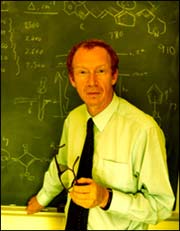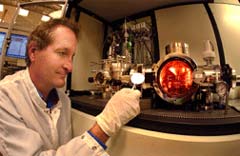Power and Electrical Engineering
This topic covers issues related to energy generation, conversion, transportation and consumption and how the industry is addressing the challenge of energy efficiency in general.
innovations-report provides in-depth and informative reports and articles on subjects ranging from wind energy, fuel cell technology, solar energy, geothermal energy, petroleum, gas, nuclear engineering, alternative energy and energy efficiency to fusion, hydrogen and superconductor technologies.

Prospects brighten for future superconductor power cables
New research from the National Institute of Standards and Technology (NIST) suggests that next-generation, high-temperature superconductor (HTS) wire can withstand more mechanical strain than originally thought. As a result, superconductor power cables employing this future wire may be used for transmission grid applications. Projected to become available in three to four years, the advanced superconductor wire (known in the industry as second generation HTS wire) is expected to cost less than the HT

Photochemistry research could lead to cleaner environment, new sensors
Alistair Lees spends much of his research time hoping to see the light.
Using tools that improve by several orders of magnitude on the accuracy of microscopes and stopwatches, Lees is working at the molecular level to explore the effect of light on chemical systems. The field is called photochemistry and Lees’ efforts could help to find less-expensive ways to produce gasoline, make the environment cleaner and safer, and enhance the quality of microcircuitry and the equipment tha

DNA used to create self-assembling nano transistor
Breakthrough proves possible to use biology to create electronics
Scientists at the Technion–Israel Institute of Technology have harnessed the power of DNA to create a self-assembling nanoscale transistor, the building block of electronics. The research, published in the Nov. 21, 2003 issue of Science, is a crucial step in the development of nanoscale devices.
Erez Braun, lead scientist on the project and associate professor in the Faculty Physics at the Technion, says scien

New Sandia UV LEDs emit short-wavelength, high-power output
Researchers achieve breakthrough in development of ultraviolet light-emitting diodes
Researchers at Sandia National Laboratories developing ultraviolet (UV) light-emitting diodes (LEDs) recently demonstrated two deep UV semiconductor optical devices that set records for wavelength/power output. One emits at a wavelength of 290 nanometers (nm) and produces 1.3 milliwatts of output power, and the other emits at a wavelength of 275 nm and produces 0.4 milliwatts of power.
“Emis

The FATRONIK-designed micro-wind generator is up and running
FATRONIK technological centre has designed and installed a micro-wind generator at the Aubixa Euskal Girotze boarding centre (San Pedro neighbourhood, Elgoibar). Since the end of October the 2.5 kW micro-wind generator has been producing energy which is initially planned to power the boarding centre’s four refrigerators, the control room, the data-reception sensors and the PCs. Moreover, four 120 kW photovoltaic plates have been incorporated into the micro-wind generator, thus generating a hybrid sys

Microbial Fuel Cells: Optimization Of The Anode Compartment For Improved Electron Transfer
A microbial fuel cell mimics a biological system, in which bacteria do not directly transfer the energy-rich electrons gained out of the feeding to their characteristic electron acceptor. Instead, the electrons are diverted towards an electrode (anode) and subsequently conducted over a resistance or power user, and a cathode (see figure). At the cathode, these electrons are used to reduce oxygen with the formation of water. This way, bacterial energy is directly converted to electrical energy.